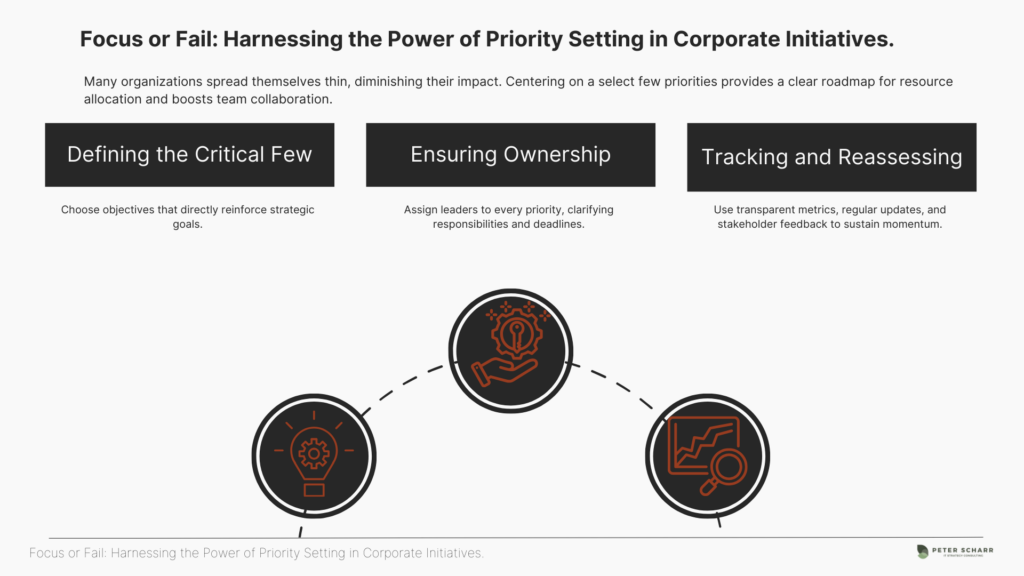In today’s high-speed corporate environment, every new trend or market demand seems to clamor for immediate attention. Many organizations struggle to juggle too many competing projects at once—leading to fragmented efforts, burned-out teams, and disappointing outcomes. By contrast, those that learn to say “no” to certain pursuits and commit strongly to a chosen few are poised for greater success. This is where the principle of “focus or fail” looms large.
Rising Pressures, Chaotic Outcomes
Global competition and heightened customer expectations are driving companies to adopt rapid transformations. Executives feel pressured to stay on top of every hot industry buzzword—from digitalization to sustainability—while also expanding core offerings. Unfortunately, failing to prioritize these efforts can lead to short-lived pilot projects, half-baked strategies, and overwhelmed team members. The net result? A scattered focus and misalignment between goals and actual resources. Instead of forging ahead decisively, businesses often stall in a cycle of frantic activity that yields minimal tangible returns.
The guiding principle, therefore, is straightforward but critical: if you do not focus, you risk failing. By establishing clear priorities, organizations are able to optimize their teams, streamline budgets, and align initiatives with genuine strategic imperatives.
Where Priorities Meet Bottom-Line Impact
When priorities are clarified and documented, executives can effectively channel the right people and resources toward projects that matter most. Rather than allocating manpower whimsically, they can concentrate assets on pivotal goals, ensuring a healthier bottom line. According to McKinsey’s management insights, companies that consistently revisit and communicate their key objectives tend to see higher overall project success rates and fewer wasted resources.
What does this look like in practice?
- Define measurable objectives: Decide how success will be measured to maintain focus. Clear metrics and indicators keep everyone on target.
- Assign ownership: Identify who is responsible for driving each priority. Clear accountability clarifies responsibilities among teams and prevents duplication.
- Track progress: Establish milestones and checkpoints. Regularly measure performance against your targets to quickly address pitfalls or opportunities.

Confronting Shifting Demands and Limited Resources
Companies often grapple with rapidly moving market forces, leaving their leaders in a tough spot: shift directions on short notice or stick to the original plan? Changing customer behaviors, new regulations, and emerging technologies can all derail even the best-laid strategies. Moreover, internal resistance—whether from team members who fear change or managers defending their individual projects—can also derail focus.
Resource constraints add another layer of complexity. With budgets constantly under scrutiny, prioritization becomes a make-or-break tool. Otherwise, an organization might dip into funds meant for strategic initiatives to keep smaller, less consequential projects afloat. Honoring priorities helps foster a culture of discipline and focus, where the workforce rallies behind core initiatives.
Building a Culture of Accountability
Establishing a clear system of accountability is essential for turning priorities into real results. Leaders should communicate the reasoning behind each priority so employees understand the bigger picture. This awareness encourages buy-in, making them more likely to take ownership of their roles. Regularly reassessing priorities—through feedback loops, quarterly reviews, or cross-departmental discussions—ensures organizations are agile and proactive. Equally critical is celebrating successes, no matter how small, to maintain morale and reinforce the benefits of staying on track.
Small Wins and Strategic Setbacks
Imagine a nationwide retailer seeking revitalization. By identifying just three core priorities—improving digital channels, streamlining supply-chain operations, and enhancing customer loyalty—the executive team allocated budgets accordingly, reappointed key staff, and halted all non-essential projects. Over time, the company saw measurable gains: higher online sales, reduced shipping costs, and better customer retention. This singular focus helped align everyone’s efforts, generating momentum that benefited the bottom line.
In contrast, consider a regional manufacturing firm that took on a dozen initiatives in one fiscal year—ranging from product overhauls to expansions into new territories. The organization quickly became overstretched. Some strategic moves lost steam due to lack of funds, while teams complained about inadequate training and support. Ultimately, the firm missed vital opportunities in their core market as attention got diluted. The lesson is clear: a scattered focus leads to a breakdown in resource management and team morale.
From these scenarios, it’s apparent that leadership must set the tone through visible commitment, transparent communication, and the willingness to revisit decisions. It is not enough to set priorities once and forget them; consistent reevaluation is key to growth in a rapidly changing environment.
Nurturing a Sharper Corporate Focus
In summary, focusing on the most critical initiatives fortifies overall corporate health. Sustained, structured priority-setting practices yield tangible results—be they cost efficiencies, revenue growth, or market differentiation. The best part? Once a culture of strategic clarity blooms in your organization, employees, partners, and stakeholders all rally behind a shared vision. This alignment not only supports existing projects but also positions the company to adapt swiftly to future shifts.
Now is the moment to take action. Revisit your current undertakings and ask: which ones directly serve our strategic objectives, and which ones can we let go? By systematically reviewing and adapting your priority framework, you are setting the scene for a steady forward trajectory, even amid waves of market change. The payoff extends beyond short-term wins—over time, focus begets resilience, a well-coordinated workforce, and long-term competitive advantage.
Thank you for reading and remember: while business environments may be unpredictable, leadership grounded in essential priorities unlocks better performance and clarity.
Commit to clear priorities,


